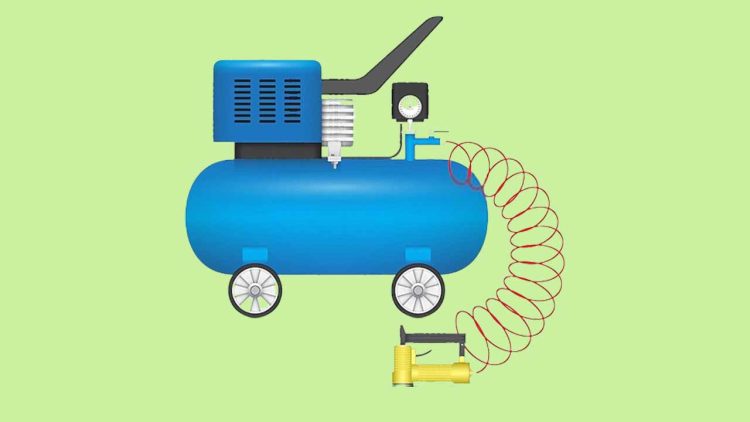A compressed air tank is a pressure vessel used to store and transport compressed air. It is typically made of steel or aluminium and can hold a range of pressures, from low to high. Compressed air tanks are used in a variety of applications, such as powering pneumatic tools, supplying air to diving equipment, and as an energy storage medium in compressed air energy storage systems.

Main Parts of a Compressed Air Tank
Here are the most important parts to know about:
Tank
The tank is the main component of a compressed air system and is designed to hold the compressed air at high pressure. It is typically made of metal such as steel or aluminium and is designed to withstand the high pressures and temperatures that are generated during the compression process. The tank should be inspected and tested periodically to ensure that it is safe to use and to prevent accidents from occurring.
Compressor
The compressor is the main component that is used to compress the air and pump it into the tank. It is typically powered by an electric motor and may be either a reciprocating or a rotary compressor. The compressor is responsible for increasing the pressure of the air and also for removing any moisture and oil present in the air.
Pressure gauge
The pressure gauge is used to measure the pressure inside the tank. It is typically located on the tank and is used to ensure that the pressure inside the tank is at the correct level. It is important to regularly check the pressure gauge to ensure that the tank is not over or under-pressurized.
Safety valves
Safety valves are designed to release pressure if the tank becomes over-pressurized. They are typically located in the tank and will open automatically if the pressure inside the tank exceeds a safe level. This prevents the tank from rupturing and causing an accident.
Air outlet
The air outlet is used to release the compressed air from the tank. It is typically located in the tank and is connected to the system in that the compressed air is being used. The air outlet is used to control the flow of compressed air and to regulate the pressure in the system.
Drain valve
Drain valves are used to drain condensate water and oil. These are typically located on the bottom of the tank and are used to remove any moisture and oil that may have accumulated in the tank.
Air filter
The air filter is used to filter the air before it is compressed. It is typically located on the intake side of the compressor and is used to remove any impurities, such as dust and debris, from the air.
Pressure switch
The pressure switch is used to control the compressor and ensure that the correct pressure is maintained in the tank. It is typically located on the compressor and is used to turn the compressor on and off as needed.
Pressure regulator
A pressure regulator is used to control the output pressure to the desired level. It is typically located after the air filter and before the tank.
Piping and fittings
Piping and fittings are used to connect all the above components and connect it to the system. They are typically made of metal such as steel or aluminium and are designed to withstand the high pressures and temperatures that are generated during the compression process.
How to Safely Use A Portable Compressed Air Tank?
- When using a portable compressed air tank, it is important to follow these safety guidelines:
- Always read and understand the manufacturer’s instructions before using the tank.
- Make sure the tank is properly filled and the pressure is within the recommended range before using it.
- Use the tank with the appropriate accessories and attachments, such as a regulator, pressure gauge, and safety valve.
- Never point the nozzle towards yourself or others, as the compressed air can cause injury.
- Do not use the tank in an enclosed space, as the compressed air can cause suffocation.
- Keep the tank away from heat sources and open flames, as it can explode if overheated.
- Store the tank in a cool, dry place, out of reach of children.
- Always use a safety valve when using a portable compressed air tank.
- Always use a pressure gauge to check the pressure in the tank before use.
- Always use a regulator to control the pressure and flow of air from the tank.
- If the compressed air tank is damaged or leaking, do not use it and replace it immediately.
- Never use a compressed air tank that is past its expiry date or has been damaged.
Conclusion
Finally, you now know how to use a portable air tank safely at your home or workshop. Always check out the manufacturer’s instructions before using a portable air tank. On top of all, make sure to take into notice all the safety measures if you are a beginner.

Meet Max, the founder and lead writer of our home improvement blog. He is a seasoned home renovation and design expert with over 8 years of experience in the industry.
Max has a passion for creating beautiful and functional living spaces and is dedicated to helping homeowners and DIY enthusiasts achieve their home improvement goals. He has worked on a wide range of projects, from small updates to full-scale renovations, and has a wealth of knowledge and experience to share.
As an avid DIYer, Max understands the challenges and rewards of tackling a home improvement project and enjoys sharing his tips, tricks and insights to make the process as easy and enjoyable as possible. In his free time, Max can be found working on his own home renovation projects, reading design blogs and magazines, and travelling to explore new design trends.
Max is excited to share his knowledge and experience with you and hopes to inspire and empower you to take on your next home improvement project with confidence. Follow Max on LinkedIn for more inspiration and expert advice.


